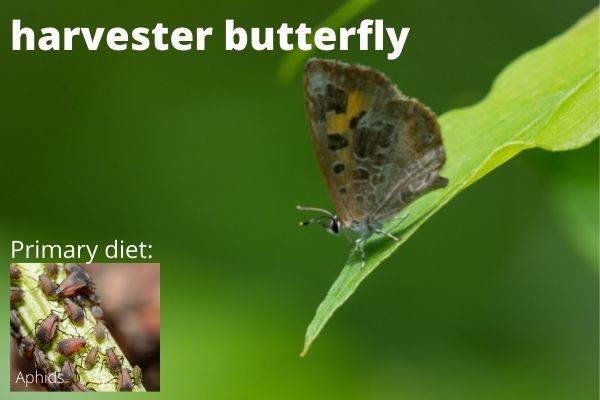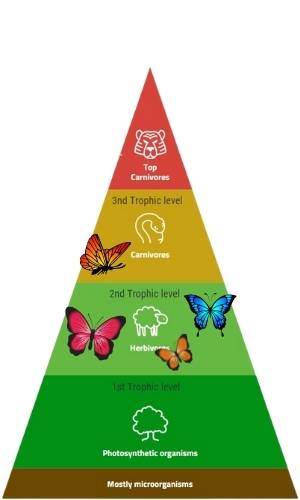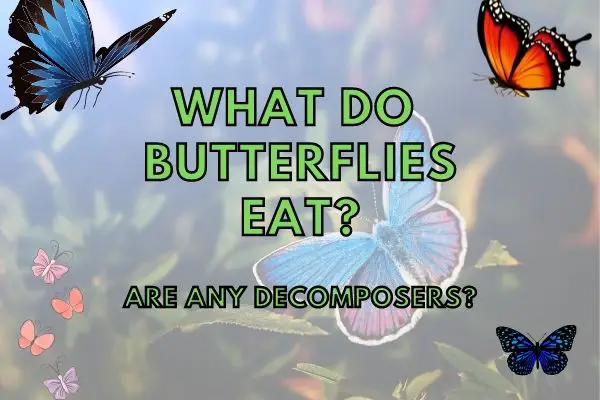Butterflies are nectarivores, which means that their diet consists of nectar from flowers. They are able to extract the nectar using their long proboscis (tongue). While feeding on the nectar, butterflies also collect pollen on their body, which they spread to other flowers as they move about.
Butterflies are not decomposers, but their babies (their larvae) may act as scavengers. Butterflies also feed on fruit juice and tree sap. In some cases, such as when migrating or during times of bad weather, butterflies may even feed on rotting fruit, insects or animal dung!
Butterflies have a very diverse diet, which is one of the reasons why they are such successful pollinators. They will feed on just about anything sweet, including nectar from flowers, honeydew from aphids, fruit juice, and tree sap.
Butterflies are found in gardens, meadows, and forests. They prefer areas with lots of flowers that they can use for nectar.
In some cases, such as when migrating or during colder times of bad weather, butterflies are more likely to feed on alternative food sources!
Primary Diet of the Butterfly
Butterflies are mostly herbivores that eat nectar from flowers. They also drink fruit juice from ripe fruits.
Some of the flowers that butterflies eat nectar from are:
- Honeydew
- Dandelions
- Buttercups
- Clovers
- Thistles
- Queen Anne’s lace
- Sage
- Mint
- Parsley
- Sunflowers
- Clovers
Butterflies use their long tongues to lap up nectar from flowers. Nectar is a sugary liquid that butterflies need for energy. Fruit juice is also a source of sugar for butterflies.
However, butterflies have a number of different diets, as varied as their habitats.
Can any Butterflies be Considered Decomposers?
No butterflies are decomposers, but some moth larvae may eat decomposing animal matter. These caterpillars feed on decaying organic matter and some are parasitoids, eating other insects.
However, some butterflies like the Blue Morpho, the Red Admiral and the Viceroy butterflies may occasionally suck out liquids from soil, faeces or dying animals e.g. exposed blood for the minerals and other nutrients present.
This behaviour may be considered scavenging, but it is not the primary feeding behaviour of these butterflies, which is still nectar from flowers when available.
Can Butterflies be Carnivores?
Butterflies are primarily herbivores. They live on plant roots, stems, leaves, seeds, nectar, fruits, wood and other plant parts.
But some butterflies are omnivores and these butterflies are considered secondary consumers because they or their caterpillers also eat animals.
Carnivorous butterflies feed on other insects. They generally feed at night. They have long, curved, sucking proboscises, which are used to pierce the skin of their victims. The proboscis is retracted when not in use.
One butterfly, the harvester butterfly, is carnivorous and it feeds primarily on aphids!

Whereas the caterpillars of butterflies may be omnivores, very few are purely carnivorous. But some caterpillars and butterflies actually eat flies and aphids!
There are about 160 species of Lepidoptera, or butterflies and moths, that are carnivorous. They belong to four families: the skippers, the butterflies, the satyrs and the owl butterflies.
The skippers are a group of small, stout butterflies, usually with drab brown or grey wings. The caterpillars feed on plants, while the adults feed on other insects, especially mosquitoes, aphids and gnats.
The satyrs, or wood-nymphs, are a group of small, brightly coloured butterflies. The caterpillars feed on plants, while the adults feed on other insects, especially ants.
The owl butterflies, or owlet moths, are a group of small (wingspan 20-25 mm), brightly coloured butterflies. The caterpillars feed on plants, while the adults feed on other insects, especially ants.
Are Butterflies Producers or Consumers?
Butterflies are consumers. In the context of ecology and food chains, organisms can be categorized into different trophic levels based on their role in the transfer of energy. Producers, also known as autotrophs, are organisms that can produce their own food through photosynthesis or chemosynthesis. They convert sunlight or inorganic compounds into organic matter, such as carbohydrates.
Butterflies, on the other hand, are consumers, specifically herbivores or, more specifically, nectarivores. They obtain their energy and nutrients by consuming plant material, primarily nectar from flowers. Butterflies have a proboscis, which is a long, tube-like mouthpart that they use to suck up nectar. Some butterflies also consume other plant parts like leaves or fruits, depending on the species.
As consumers, butterflies play an important role in the ecosystem by pollinating flowers while feeding on nectar. They transfer pollen from one flower to another, aiding in the reproduction of flowering plants.
What Type of Consumer is a Butterfly?
Butterflies are considered primary consumers or herbivores. They primarily feed on plant material, such as nectar from flowers. Nectar is their main source of energy and nutrients. Butterflies have specialized mouthparts called proboscis that they use to suck up the sweet liquid from flowers.
While nectar is their primary food source, some butterfly species may also consume other plant parts like leaves or fruits, depending on their specific dietary preferences. However, the majority of their diet consists of nectar, making them primarily herbivorous consumers in the ecosystem.
Butterflies are mostly primary consumers because they eat primarily plants, but some butterflies also eat insects and are therefore secondary consumers. Generally, herbivores are primary consumers, omnivores are secondary consumers and carnivores are tertiary consumers.
Where are Butterflies in the Food Chain?
Butterflies occupy various positions in the food chain depending on their life stage and the specific ecosystem they inhabit. Let’s consider a generalized food chain to understand where butterflies typically fit:

In a basic food chain, plants are the primary producers that convert sunlight into energy through photosynthesis. Butterflies, as herbivores, consume plant material, primarily nectar from flowers.
Therefore, they occupy the position of primary consumers or herbivorous consumers in the food chain. They obtain energy and nutrients by feeding on the producers (plants).
But butterflies also have their own predators, which are organisms that feed on them. These predators can include birds, spiders, reptiles, mammals, and even other insects. So, butterflies are also part of the diet for various secondary and tertiary consumers in the food chain.
It’s important to note that butterflies have a complex life cycle that involves various stages, including eggs, caterpillars (larvae), pupae (chrysalis), and adult butterflies. Each stage may have different interactions within the food chain. For example, caterpillars may be preyed upon by certain insects, birds, or other small animals, while adult butterflies may be targeted by different predators.
Overall, butterflies play a role as both consumers and potential prey in the food chain, contributing to the flow of energy and matter within ecosystems.
Are Butterflies Autotrophs or Heterotrophs?
Butterflies are heterotrophs because they eat other living organisms. Practically (almost) no animals are autotrophic because animals do not get their energy directly from the sun like plants do. That is, animals like the butterfly cannot make their own energy, but need to eat other organisms as their energy and carbon source.
What Animals Hunt and Eat Butterflies?
Several animals hunt and eat butterflies as part of their diet. Here are some examples of common predators of butterflies:
- Birds: Many bird species, including sparrows, finches, warblers, and hummingbirds, feed on butterflies. They are often attracted to the bright colors and fluttering movements of butterflies, making them a target for bird predation.
- Insects: Some insects prey on butterflies, especially their eggs and caterpillars. Predatory insects such as wasps, ants, beetles, and mantises may actively seek out and consume butterfly larvae.
- Spiders: Certain spider species capture butterflies in their webs. These include orb-weaving spiders that build intricate, sticky webs to catch flying insects like butterflies.
- Reptiles and Amphibians: Some lizards, including anoles and skinks, may feed on butterflies if given the opportunity. Additionally, certain amphibians like frogs and toads can prey on butterflies that come within their reach.
- Bats: Nocturnal butterflies may become prey for bats that are adapted to hunting flying insects during the night. Bats use echolocation to locate and capture their prey.
- Small Mammals: Some small mammals, such as mice, shrews, and rodents, may occasionally consume butterflies, particularly if they encounter them during their foraging activities.
It’s important to note that not all butterflies are equally vulnerable to predation, as some species have evolved defense mechanisms like toxic chemicals, camouflage, or mimicry to deter or confuse potential predators. Nonetheless, butterflies are an important food source for various predators in their respective ecosystems.
Conclusion
In this blog post I have looked into the diet of the butterfly as an animal that is rarely thought about on a day to day basis.
Butterflies are a group of insects that are often considered as beautiful, but their diet is actually quite different to what we think of as a typical insect diet!
Butterflies are not only beautiful, but they are also an important pollinator of many plants and flowers. Butterflies are also important for the health of ecosystems because they act as a natural pest control.
Butterflies are also a very important food source for other animals, including birds and mammals.
Butterflies are usually a good indicator of the health of an ecosystem because they are sensitive to pollution and a well kept garden can house more than 10 species of butterflies!
I hope you enjoyed reading this article, and I do encourage you to look into my other articles on this blog for more exciting facts about wildlife and animal diets!




